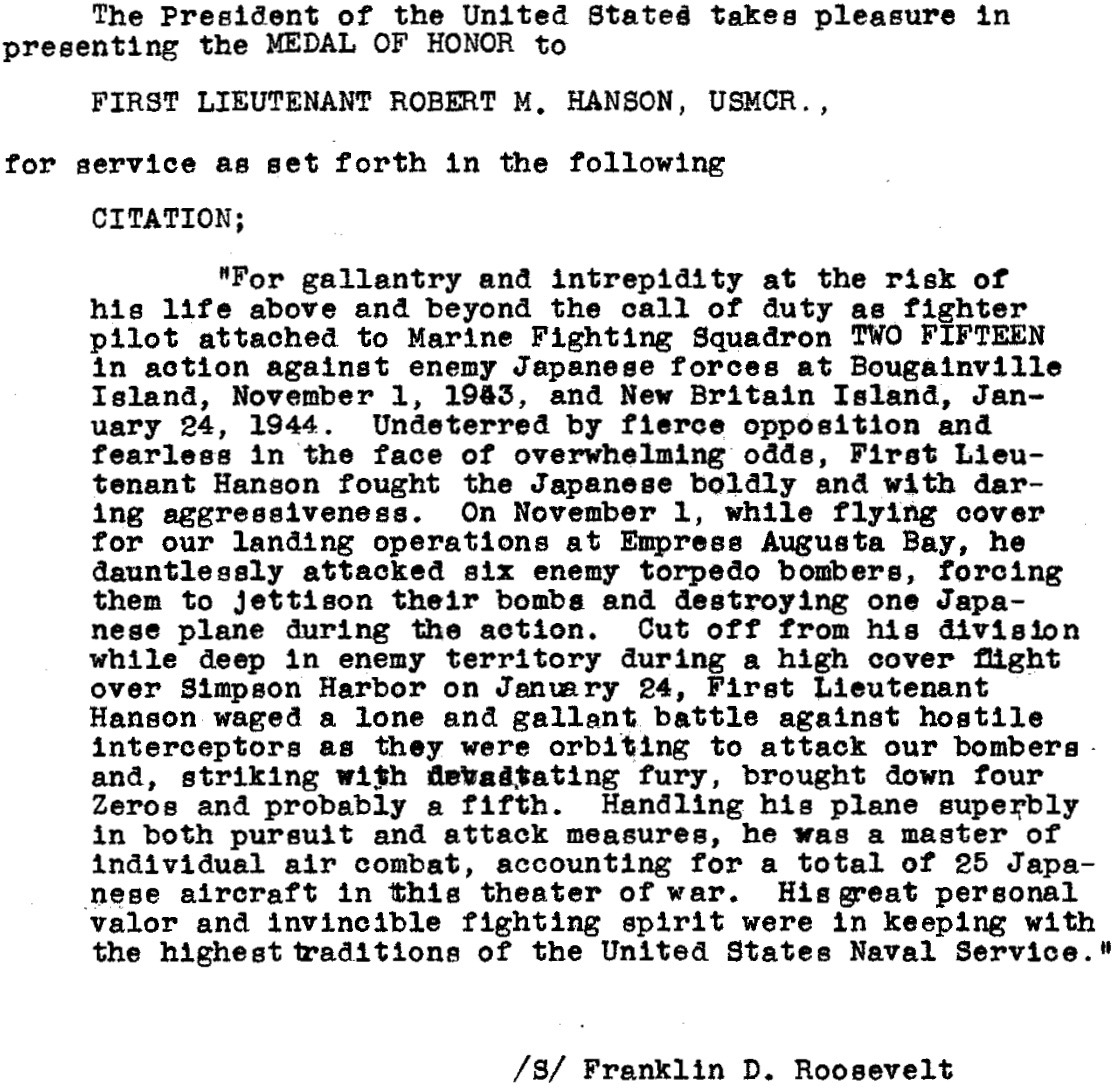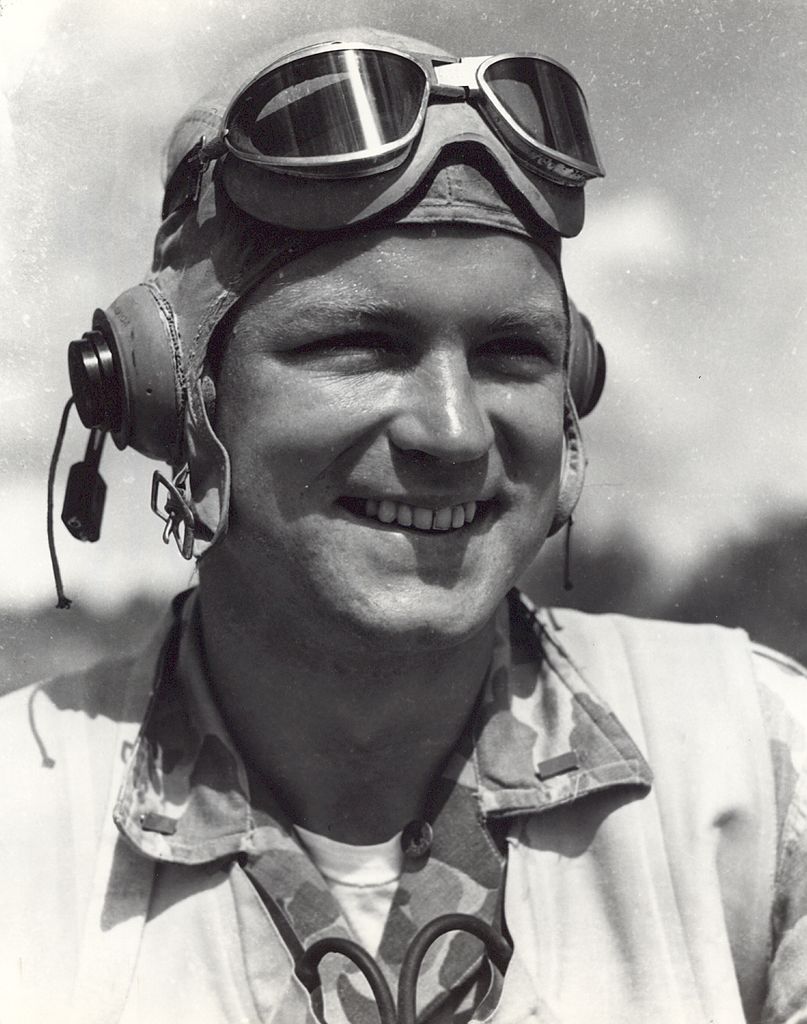
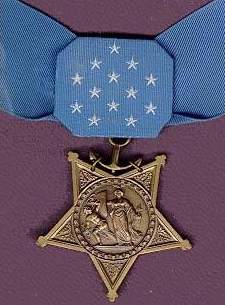
The Medal of Honor was presented to Lieutenant Hanson’s mother by Major General Lewis G. Merritt at a ceremony on Boston Common, Boston, Massachusetts, 19 August 1944. (His father, Rev. Dr. Harry A. Hanson, was at the time in India as president of the Lucknow Christian College.)
Robert Murray Hanson was born 4 February 1920 at Lucknow, Uttar Pradesh, India, the second of four children of Rev. Dr. Harry Albert Hanson and Alice Jean Dorchester Hanson. His parents were Methodist missionaries; his father a teacher at the Lucknow Christian College. He had an older brother, Mark, younger brothers Stanley and Earl Dorchester Hanson, and sister Edith Hazel Hanson.
The family returned to the United States, arriving at New York (via Liverpool and Rotterdam) aboard Cunard passenger liner S.S. Ausonia, 19 February 1924.
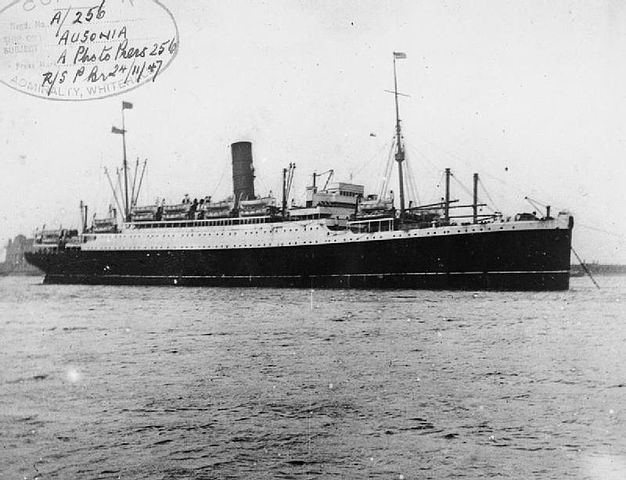
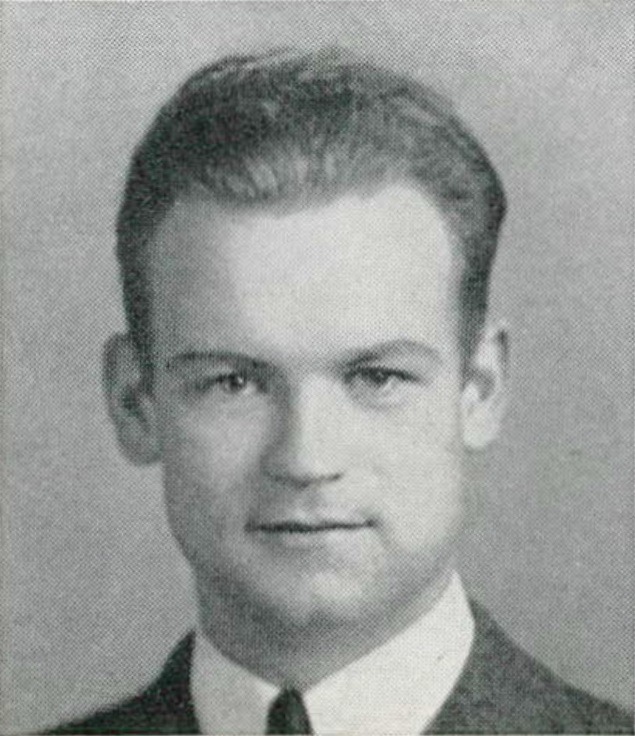
Hanson attended school in the United States, then returned to India. He again returned to the United States in 1938, having taken time to bicycle through Europe. He attended Hamline University at St. Paul, Minnesota, a member of the Class of 1942. Hanson majored in economics, and was a member of the Kappa Gamma Chi (ΚΓΧ ) fraternity and the H Club. He played on the football, tennis, track and wrestling teams. He was an All State athlete.
When Hanson registered for the draft (conscription), 1 July 1941, he was described as having a light complexion, blonde hair and blue eyes. He was 5’10¾” tall (182.3 centimeters) and weighed 195 pounds (88.5 kilograms).
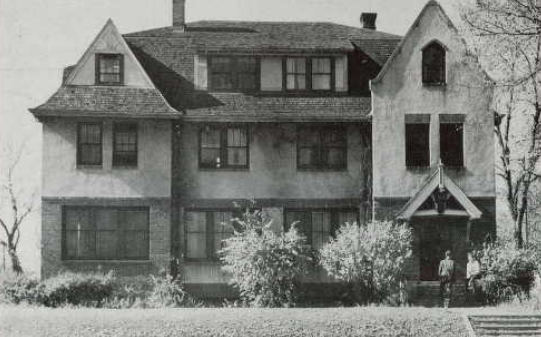
Bob Hanson left the university and enlisted in the U.S. Naval Reserve as Seaman 2nd Class (V-5 Aviation Cadet Training Program), at the Naval Aviation Base, Minneapolis, Minnesota, 26 February 1942. (Service Number 411 88 11)
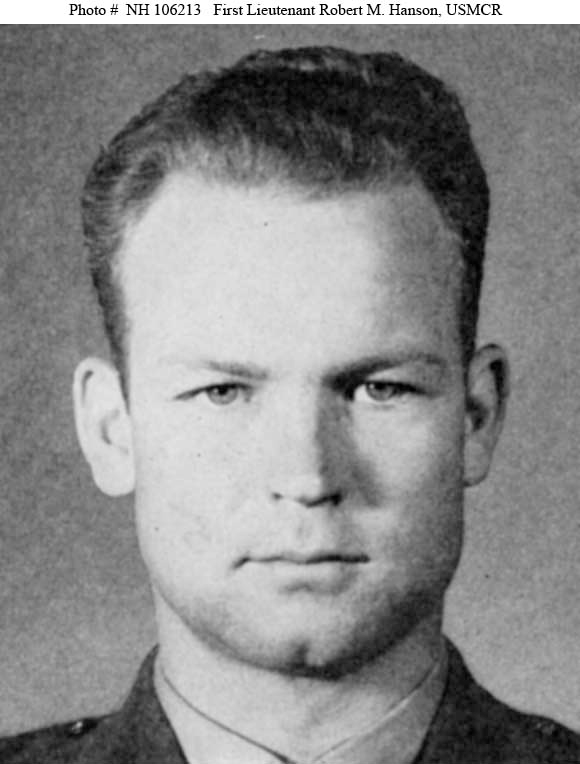
Hanson completed flight training and was commissioned a second lieutenant, United States Marine Corps Reserve (Service Number O-019154), at Corpus Christi, Texas, 19 February 1943. Assigned to the Marine Corps Air Station at Kearney Mesa, San Diego, California, he was then transferred to the First Marine Aircraft Wing for deployment to the South Pacific.
When he arrived in the Solomon Islands, Lieutenant Hanson served with Marine Fighting Squadron 214 (VMF-214), known as the “Swashbucklers” (previously known as “The Black Sheep” under the command of Major “Pappy” Boyington). He was transferred to VMF-215, “The Fighting Corsairs,” at Vella Lavella Island, under the command of Major (later, Major General) Robert Gordon Owens, Jr., in October 1943.
On 1 November 1943, while flying F4U-1 Corsair Bu. No. 17472, Hanson was shot down near Bouganville by the rear gunner of a Nakajima B5N2 Type 97 (“Kate”). After six hours in a raft, he was rescued by the Fletcher-class destroyer USS Sigourney (DD-643).
1st Lieutenant Hanson was awarded the Air Medal at Vella Lavella, 20 November 1943.
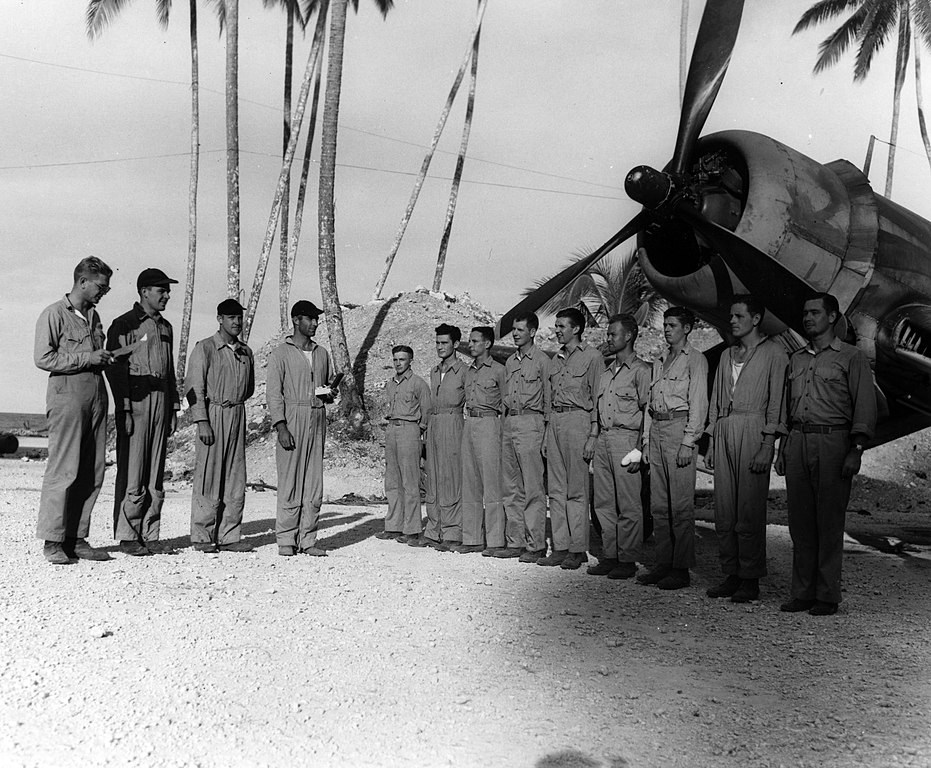
“Photo shows, left to right: 1st Lt. Robert E. Clark reading citations, Major Robert G. Owens Jr., Major James L. Neefus, Lt Col. Herbert H. Williamson, 1st Lt. Lincoln F. Deetz, (Gold Star), 1st Lt. Bennie P. O’Dell (Air Medal), 1st Lt. David R. Moak (Air Medal), Capt. Don Aldrich (Purple Heart), 1st Lt. Drury E. McCall (Air Medal), 1st Lt. Robert M. Hanson (Air Medal), 1st Lt. Thomas M. Tomlinson (Air Medal), 1st Lt. Otto K. Williams (Air Medal), and 1st Lt. Grafton S. Stidger (Purple Heart).
“Date 20 November 1943.” (Source USMC Military History Division: Defense Department Photo (Marines): 68310)
Between 4 August 1943 and 30 January 1944, Hanson shot down 25 enemy aircraft:
4 August 1943: 1 Kawasaki Ki-61 Hien Type 3 (“Tony”)
26 August 1943: 1 Mitsubishi A6M2 Type 0 (“Zero”)
1 November 1943: 2 Mitsubishi A6M2 Type 0, 1 Nakajima B5N2 Type 97 (“Kate)
14 January 1944: 5 Mitsubishi A6M2 Type 0
20 January 1944: 1 Mitsubishi A6M2 Type 0
22 January 1944: 2 Mitsubishi A6M2 Type 0, 1 Kawasaki Ki-61 Hien Type 3
24 January 1944: 4 Mitsubishi A6M2 Type 0, (1 Ki-61 probable)
26 January 1944: 3 Mitsubishi A6M2 Type 0, (1 A6M2 probable)
30 January 1944: 2 Mitsubishi A6M2 Type 0, 2 Nakajima Ki-44 Shoki (“Tojo”)
On 3 February 1944, the day before his 24th birthday, while flying a Chance Vought F4U-1 Corsair, Bu. No. 56039, 1st Lieutenant Hanson was part of an 8 Corsair escort for 18 Grumman TBF Avenger torpedo bombers in an attack on the Tobera Airfield (Rabaul No. 4) near Keravat, New Britain. While returning, Hanson descended to attack a light house at Cape St. George. His fighter was hit by anti-aircraft gunfire. His commanding officer, Major Owens, reported,
“Bob was coming back from a flight covering bombers to Rabaul on February 3rd when he apparently decided to strafe a lighthouse at Cape St. George, at the southern tip of New Ireland. He made a strafing run, and then his right wing was seen to hit the water twice. The plane pulled up and the wing either exploded or caught fire. After a moment when it seemed he would make a normal landing, the plane twisted and rolled over and disappeared.”
His wingman, Lieutenant Harold Leman Spears, searched and found only floating debris.
The Boston Daily Globe reported:
The Story of Newton’s Heroic Ace
BOB HANSON OF THE MARINES
Off to Pacific and a Brilliant Record
By Frances Burns
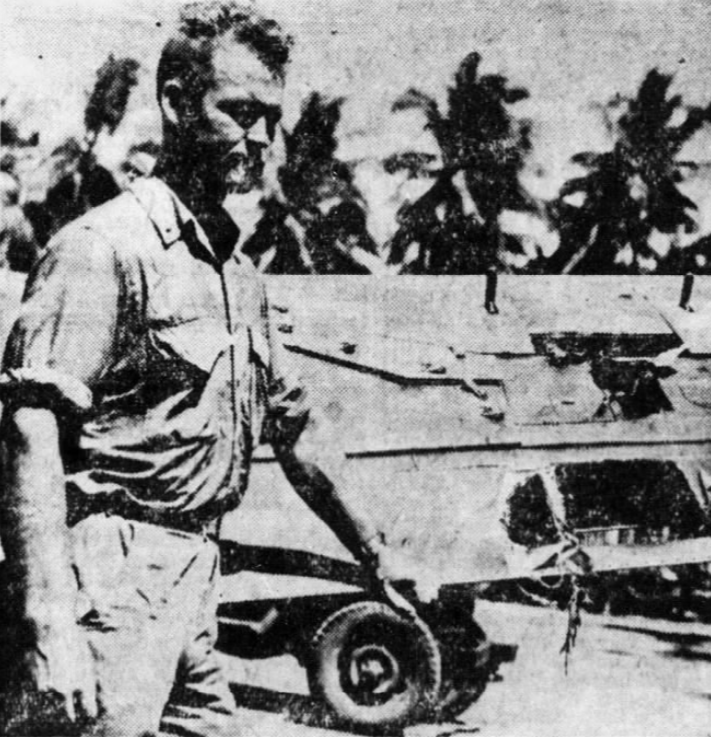
2d Lt Robert Murray Hanson was almost ready for his meteoric career as a fighting pilot in the South Pacific when he rang the doorbell at 31 Brooks av., last Good Friday morning.
Bob Hanson had seen his parents, Rev. and Mrs. Harry Hanson, six hours in the five years since he left Lohdipur. He had won his wings two months before in Miami the month before he had his first challenge as a flyer, when to avoid a collision he flipped his plane, somersaulted and crawled out intact.
* * *
Now he was like other boys who came home for the last time before going out SOMEWHERE to fight in this war. He didn’t want to do much visiting. He didn’t want to be entertained. He wanted to play with his young counterpart, flaxen haired, blue eyed bouncing sister Edith; talk about their hikes in the fields of India with his father; discuss birds with his youngest brother Earl; and open his heart over the dishpan to his mother. He wanted to be left alone to go off in a corner to read when he felt like it.
He spent most of three days of his six at home making himself a knife like a Roman sword, a knife that he was probably to use in the incredible months ahead.
“We thought, his father and I, that if Bob ever had a chance when he cracked the other day he would have been able to cut his way out of the wreckage with that knife,” his mother said last week. “It helps us keep hoping.”
Hanson went on to see his brothers Mark and Stanley in Chicago at the end of his leave, to San Diego for a brief commando training and then overseas.
The flyer’s first two letters home never were received and except for a government card announcing his safe arrival in July his family had no word from May to September, except indirectly.
* * *
There have been a few brief letters since but most of their son’s breathtaking saga Mr. and Mrs. Hanson have read in dispatches from the South Seas. . . .
. . . . Lt Robert M. Hanson in his first encounter early in August against the enemy shot down a Zero with the guns on his left wing after Japanese cannon had ripped through his right wing. . . .
. . . . Second Zero in September on a bomber escort mission. . . .
. . . . reported missing in action Nov. 1 after he had shot down three more planes to become an ace, 2d Lt Robert Hanson was picked up by a destroyer after his engine conked out and he had to take to a rubber boat. (He wrote his parents Nov. 5 of his rescue and not to give up hope if he were reported lost—”there were so many islands out there.”). . . .
. . . . 1st Lt Robert M. Hanson, ace, today (Jan. 5 delayed) was decorated with the Air Medal and cited by Adm Halsey, South Pacific commander. . . .
. . . . Big blond Bob Hanson, currently the hottest fighter pilot in the Allied South Pacific front, today (Jan. 22 delayed) shot three more Japanese fighting planes out of the sky over New Britain to run his score to 14, with an average of one a day this week. . . .
. . . . Lt Hanson became the ace of Marine Corps flyers Jan 24 when he ran the total of Japanese planes to his credit to 18. . . picked off four Zeros today. . . .
. . . . Feb. 2 Lt Robert M. Hanson shot down four Japanese planes, including two new models to boost is total to 25 and made him the leading South Pacific ace in action. . . .
And Feb. 3, a fellow pilot saw a Corsair make a strafing run at St. George Cape, New Ireland, but it pulled out too late. A wing caught the water and she somersaulted. “I went down low but saw only wreckage.” . . . Marine Lt Robert M. Hanson with 20 planes in 17 days was within one short of the record held by Capt Eddie Rickenbacker of World War I, Maj Joe Foss and Gregory Boyington. . . on the day before his 24th birthday Lt Robert M.Hanson is missing in action.
—The Boston Daily Globe, Vol. CXLV, No. 50, 19 February 1944, Page 4, Columns 3–5
In addition to the Medal of Honor, 1st Lieutenant Robert Murray Hanson, USMCR, was awarded the Navy Cross,² the Purple Heart with gold star, the Air Medal, Combat Action Ribbon, Presidential Unit Citation, American Campaign Medal, Asiatic-Pacific Campaign Medal with two bronze stars, and the World War II Victory Medal.
The Gearing-class destroyer USS Hanson (DD-832) was named in his honor. Built at the Bath Iron Works, Bath, Maine, the 3,460 long ton ship was commissioned 11 May 1945, under the command of Commander John C. Parham, USN. Hanson served during the Korean War. She was re-classified as to a radar picket destroyer (DDR) in 1949. In 1973, Hanson was transferred to the Republic of China Navy and renamed Liao Chiang (DDG-932). The ship was sunk as a target in July 2006.
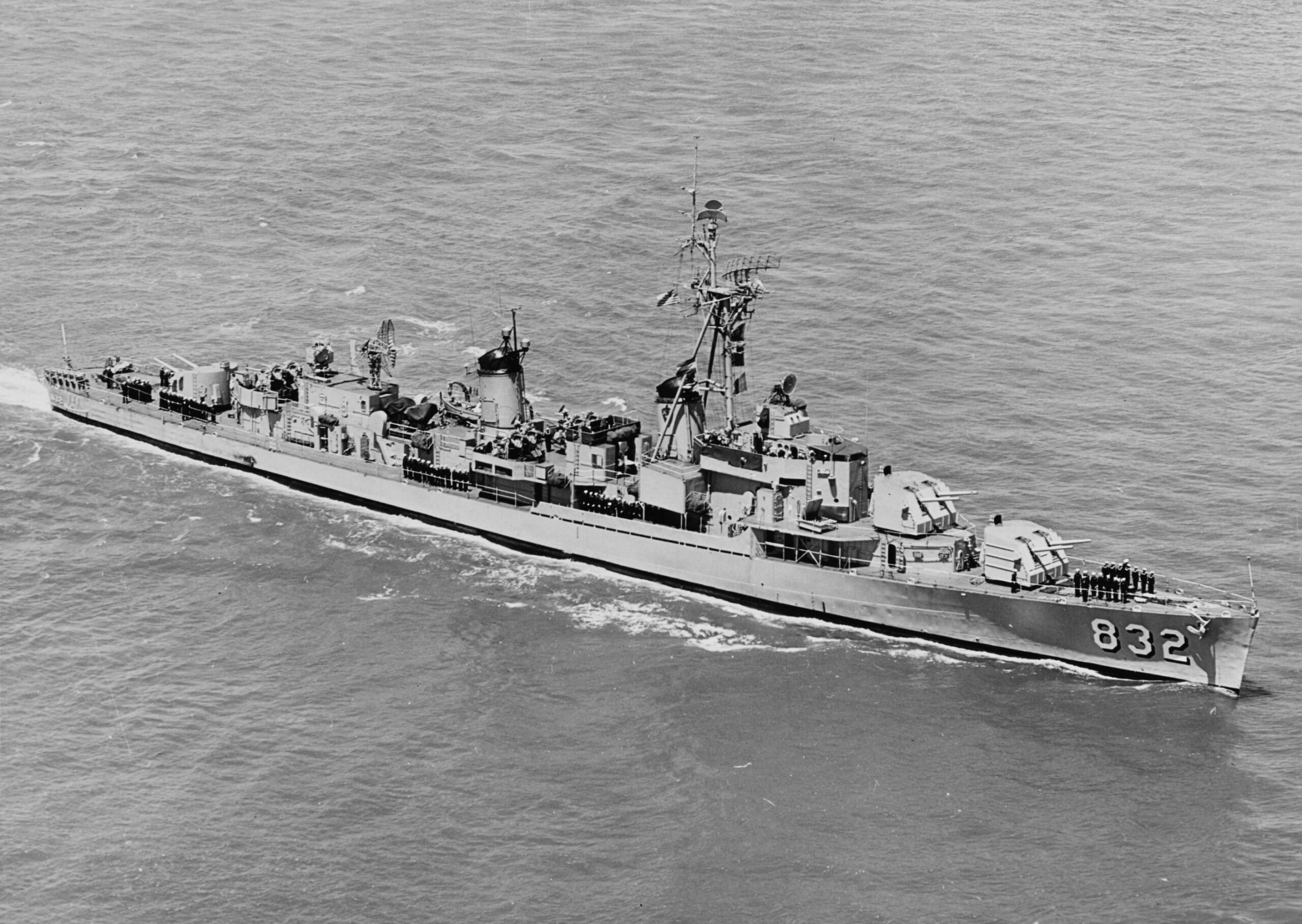
Hanson’s name appears on a Trani limestone pier at the Manila American Cemetery and Memorial at Fort Bonifacio, Taguig City, Phillipines. There is also a cenotaph at the Newton Cemetery, Newton, Massachusetts.
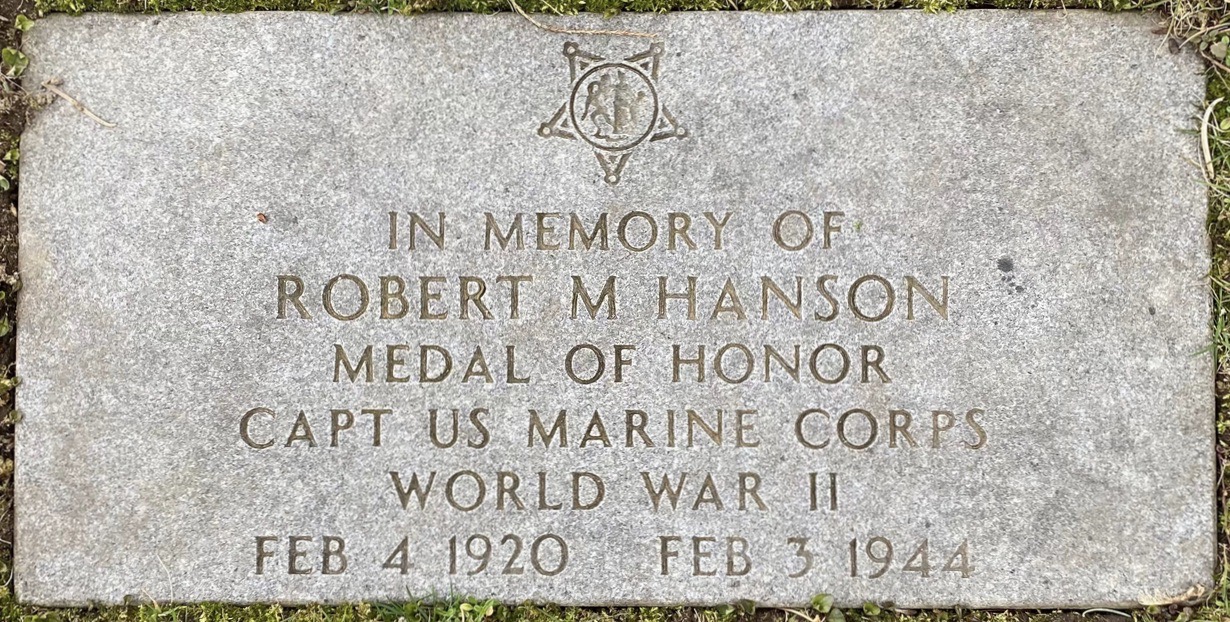
VMF-214 and VMF-215 flew the Vought-Sikorsky Aircraft Division F4U-1 Corsair.¹ The Corsair was designed by Rex Buren Beisel, and is best known for its distinctive inverted “gull wing,” which allowed sufficient ground clearance for its 13 foot, 4 inch (4.064 meter) diameter propeller, without using excessively long landing gear struts. The prototype XF4U-1, Bu. No. 1443, had first flown 29 May 1940, with test pilot Lyman A. Bullard in the cockpit.
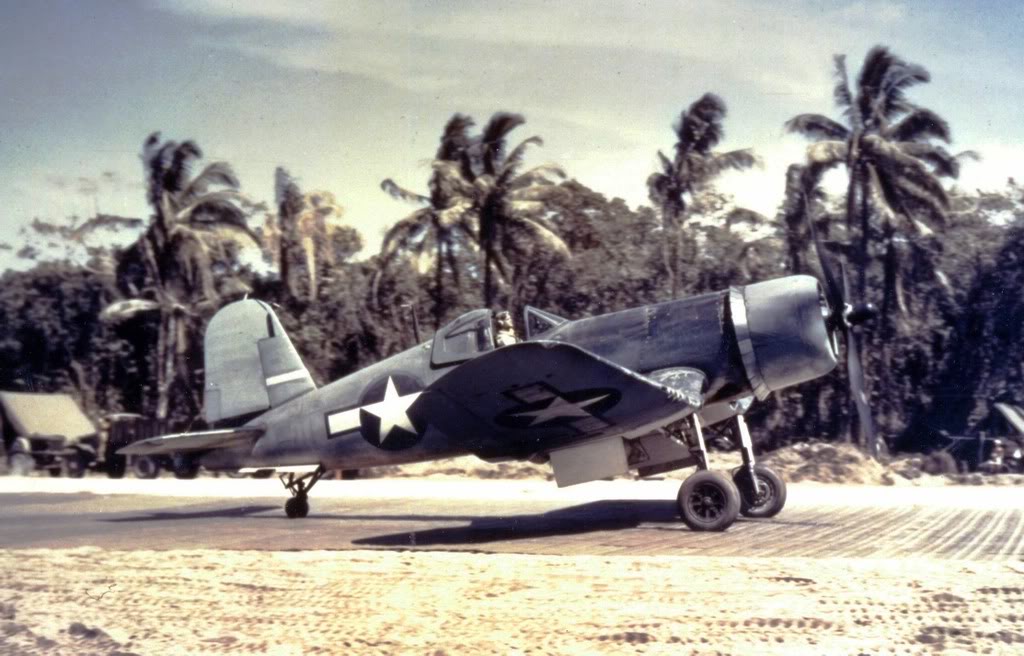
The F4U-1 was 33 feet, 4.125 inches (10.163 meters) long with a wingspan of 40 feet, 11.726 inches (12.490 meters) and overall height (to top of propeller arc) of 15 feet, 0.21 inches (4.577 meters). The wings’ angle of incidence was 2°. The outer wing had 8.5° dihedral and the leading edges were swept back 4°10′. With its wings folded, the width of the F4U-1 was reduced to 17 feet, 0.61 inches (5.197 meters), and increased the overall height to 16 feet, 2.3 inches (4.935 meters). When parked, the Corsair’s 13 foot, 4 inch (4.064 meter) propeller had 2 feet, 1.93 inches (65.862 centimeters) ground clearance, but with the fighter’s thrust line level, this decreased to just 9.1 inches (23.1 centimeters). The F4U-1 had an empty weight of 8,982 pounds (4,074.2 kilograms) and gross weight of 12,162 pounds (5,516.6 kilograms).
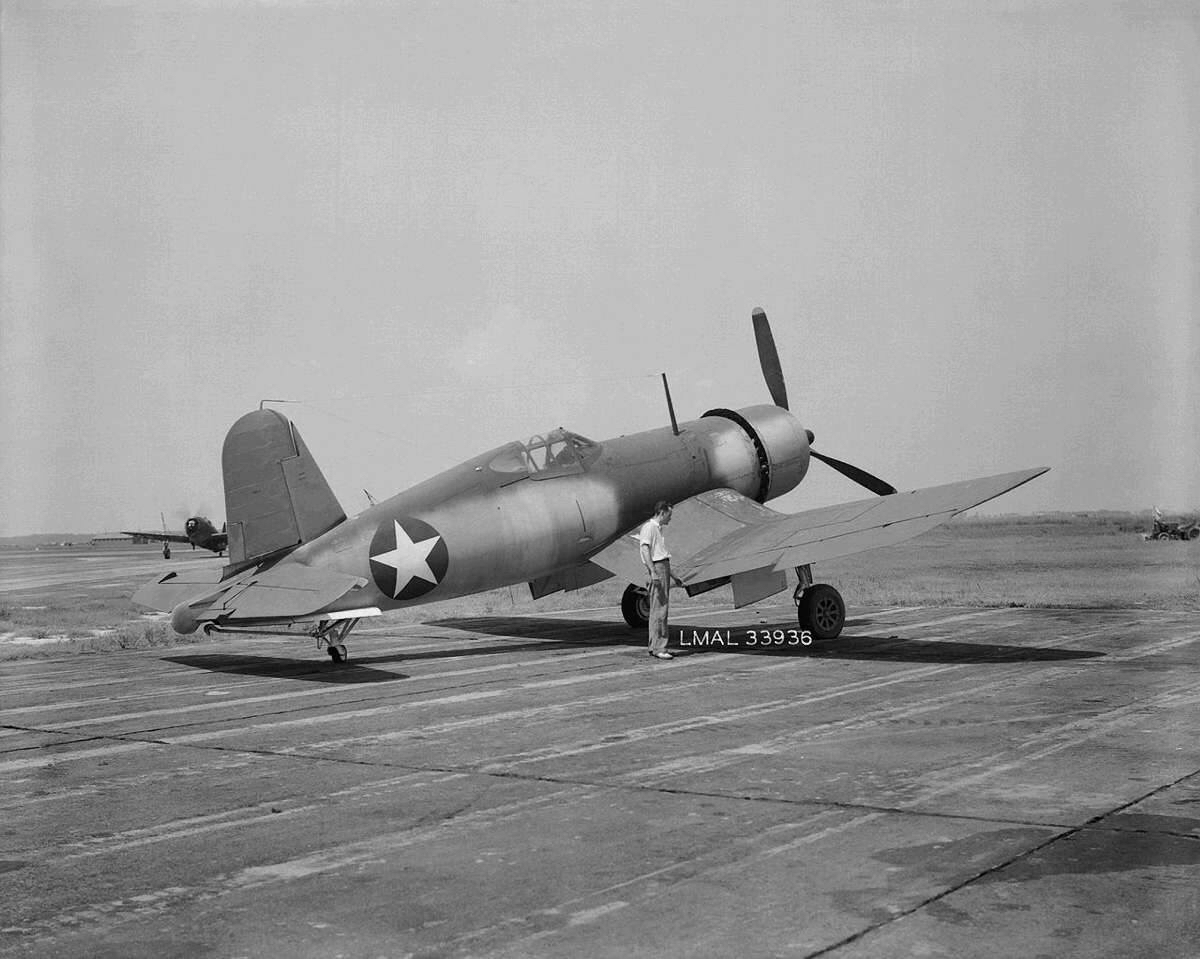
The F4U-1 variant of the Corsair was powered by an air-cooled, supercharged, 2,804.4-cubic-inch-displacement (45.956 liter) Pratt & Whitney Double Wasp SSB2-G (R-2800-8) two-row, 18-cylinder radial engine, with a compression ratio of 6.65:1. The R-2800-8 had a normal power rating of 1,675 horsepower at 2,550 r.p.m. and 44.0 inches of manifold pressure (1.490 bar) at 5,500 feet (1,676 meters); 1,550 horsepower at 21,500 feet (6,553 meters); and 2,000 horsepower at 2,700 r.p.m. with 54.0 inches of manifold pressure (1.829 bar) for takeoff. The engine turned a three-bladed Hamilton Standard Hydromatic constant-speed propeller with a diameter of 13 feet, 4 inches (4.064 meters) through a 2:1 gear reduction. The R-2800-8 was 7 feet, 4.47 inches (2.247 meters) long, 4 feet, 4.50 inches (1.334 meters) in diameter and weighed 2,480 pounds (1,125 kilograms).
The F4U-1 had a cruise speed of 186 miles per hour (299 kilometers per hour) at Sea Level. Its maximum speed at Sea Level was 365 miles per hour (587 kilometers per hour). During flight testing, an F4U-1 reached 431 miles per hour (694 kilometers per hour) at 20,300 feet (6,187 meters) with War Emergency Power. The service ceiling was 38,200 feet (11,643 meters) and its maximum range was 1,510 miles (2,430 kilometers) with full main and outer wing tanks.
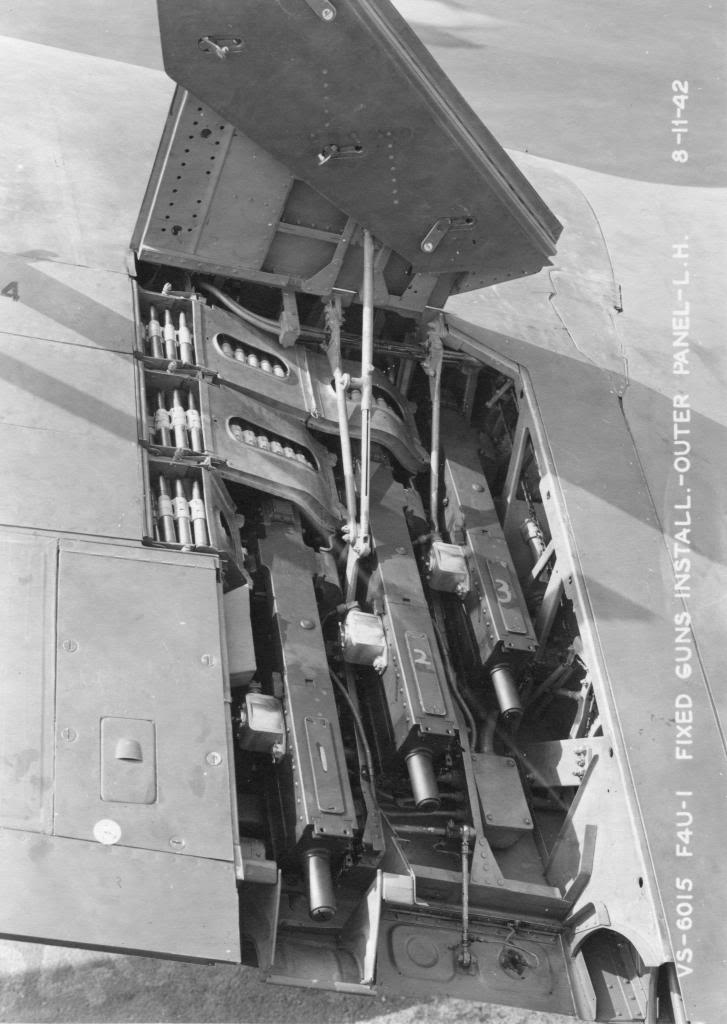
The Corsair was armed with six air-cooled Browning AN-M2 .50-caliber machine guns, three in each wing, with 400 rounds of ammunition per gun.
A total of 12,571 Corsairs were manufactured by the Vought-Sikorsky Aircraft Division (F4U-1), Goodyear Aircraft Corporation (FG-1D) and Brewster Aeronautical Corporation (F3A-1). The Corsair served the U.S. Navy and Marine Corps in World War II and the Korean War. Corsairs also served in other countries’ armed forces. Its last known use in combat was in Central America in 1969.
¹ Hanson’s Corsair is usually identified as a “F4U-1A.” F4U-1A is not an official U.S. Navy designation, but is commonly used to distinguish late production F4U-1 Corsairs with their blown plexiglas canopies and other improvements from the earlier “bird cage” Corsairs.
² Citation for the Navy Cross:
The President of the United States of America takes pleasure in presenting the Navy Cross to First Lieutenant Robert Murray Hanson (MCSN: 0-19154), United States Marine Corps Reserve, for extraordinary heroism and distinguished service in the line of his profession as Pilot of a Fighter Plane attached to Marine Fighting Squadron TWO HUNDRED FIFTEEN (VMF-215), Marine Air Group FOURTEEN (MAG-14), FIRST Marine Aircraft Wing, in aerial combat against enemy Japanese forces in the Solomon Islands Area from 5 January 1944 to 3 February 1944. Intercepted by a superior number of Japanese fighters while covering a flight of our bombers in a strike against enemy shipping in Simpson harbor on 14 January, First Lieutenant Hanson boldly engaged the hostile planes in fierce combat, pressing home repeated attacks with devastating force. Separated from his squadron during the intense action, he valiantly continued the engagement alone, successfully destroying five enemy Zeros before being forced by lack of ammunition and gasoline to return to his base. First Lieutenant Hanson’s superb airmanship, brilliant initiative and dauntless fighting spirit enabled our bombers to deliver a crushing blow to the Japanese in that sector and return safe to their base and his conduct throughout was in keeping with the highest traditions of the United States Naval Service.
© 2023, Bryan R. Swopes
